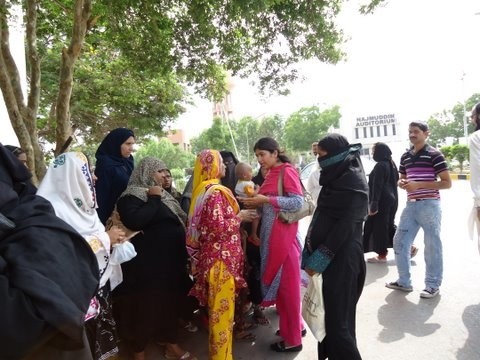
Pirya (in pink dress) guides patients to the relocated facilities.
Winrock
Conscientious construction saves lives
“For a moment I imagined my own sister in her place and that was it. I was desperate to help the young woman and ease her pain.” - Pirya Kanwal, a social mobilizer for a USAID-funded project in Karachi
Pirya Kanwal is a trained Lady Health Visitor (LHV). She works as a social mobilizer for the USAID’s Community Rehabilitation Infrastructure Support Program (CRISP). She has worked as LHV in Sukkur district, Sind province and later served poor and needy with a variety of other organizations. When advertised for the position of a social mobilizer, Pirya took it as an opportunity to work on the helping women and children in need for medical care.
USAID’s CRISP program brings together best practices in sustainable development and quality construction to build health and education facilities throughout Pakistan. A keystone of this approach is using such techniques as Social Mobilization, whereby stakeholders are invited to participate in the design and construction of their facilities. Social Mobilizers play a vital role in helping patients reach alternate facilities to minimize disruptions to ongoing services while the construction is going on.
This approach proved to be very important at the Jinnah Post Graduate Medical Center. Through CRISP, USAID is constructing a new state-of-the-art outpatient ward and the only Fistula Center in the entire province. These facilities will cater to the underserved female population of Karachi and surrounding districts.
That day, Pirya found a young pregnant woman nearly unconscious and in critical condition at the gate of the outpatient ward that USAID is reconstructing. The woman’s mother was desperately crying for help. “For a moment, I imagined my own sister in her place, and that was it,” said Pirya. She approached the two women and explained that the ward had been relocated temporarily due to construction. Seeing that the pregnant woman was in lots of pain, Pirya took the two women to the relocated facility. Having worked at the hospital for several months, Pirya was well acquainted with the hospital staff, and was able to get attention of a resident doctor quickly. “They gave her necessary medical aid and admitted her for the surgery that saved her life,” says Pirya.
A few days later, the mother and husband of the patient visited Pirya. Filled with tears of gratitude, they thanked her for saving the life of their loved one and promised to keep her and her organization in their prayers.
December 2011
File Attachment







Comment
Make a general inquiry or suggest an improvement.